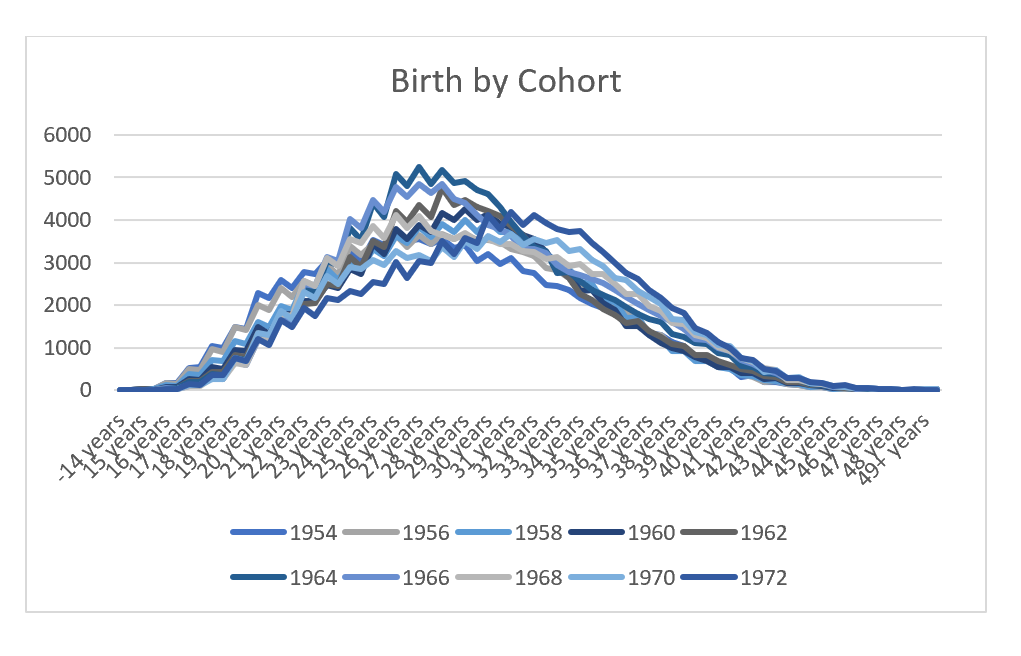One of my favourite things to do in life it so look at “received wisdom” and see if its actually right or not. A previous article stated that governments could choose any level of inflation that they want - and to ignore demographics which many people insisted implied deflation forever. In particular, I pointed out in the 1980s, UK population growth was negative at a period of high inflation.
A justified criticism of this would that the UK population is much older now than it was in 1980s, so this is deflationary. Fair enough. But somehow I felt this argument was old and stale, and ripe for pushback. So I decided to see if I could find data arguing the opposite. And luckily for me, and you dear reader, I found some really good counterarguments. In fact it makes me think we could be on the precipice of a baby boom.
So the main driver of an aging and shrinking population is that women are having less children, and they are having them older. While this seems negative, the implication is that women, and particularly young women have more say over when they have children - which is a positive. But it seems to me, that with modern technology it just means that women have children later, but not necessarily less. During the adjustment phase from women having children young, to having children when mature, it will look like fertility is declining, and the population is aging, but this is a one time adjustment before we return to trend growth rates. That’s my theory. To test it, you need a country with very advanced gender equality, and good fertility statistics. Fortunately, Sweden has both.
If we look at total fertility rates (estimate births per 1000 women over their lives), Sweden has been below natural replacement rates since the mid 1970s. (You need 2000+ births to replace the mother and father over time).
Swedish Fertility rates for young women have collapsed, with teenage pregnancies almost unknown. While older women are having more children, when we break fertility down by age groups, it gives the impression of that fertility rates have topped out in all age groups. And so even in progressive Sweden, demographic deflation seems destiny.
However (and there has to be a however, otherwise why write this note!), Sweden provide data on age of the mother on an annual basis starting in 1968. With a little bit of work, I have been able to make charts that show when a cohort of mothers are having children. So the earliest cohort we can do are mothers born in 1954, and I have included mothers born in 1973 as they are now entering their 49th year, which is where Swedish stats draw the line on fertility statistics. Broadly speaking, peak births has been falling, and then shifting to the right (I have just included even years to make the charts cleaner)
This shift from younger mothers, to older mothers will slow population growth, and age the population. But what happens if this rightward shift stops? Looking at cohorts born from 1974 onwards, we can see signs of stabilisation, as well as increasing signs of an increase in number of births at all ages over 28.
When you study demographics, the baby boom is often explained as women having many children as they were used to higher infant mortality rates. When healthcare suddenly improved, less babies died and we end up with a population boom. As a corollary to that, I think from 1970s onwards we have been in an adjustment where women have realised they can have a career and be a mother, and have naturally adjusted their childrearing plans, but not to having less children, but just having them later. This is a one off adjustment, which in Sweden at least looks like it is coming to an end.
A final observation I would make is that fertility rates were high when government policies favoured labour over capital from the end of World War II to the 1970s. I wonder if a return to pro labour policies would cause a natural increase in birth rates, just as the demographic shift to older mothers is coming to an end. I speak from experience as I am third born in my family, and as my mother used to tell me, very pro labour and pro women policies introduced by the Gough government in Australia made me possible. I think we are in a period of pro-labour policies, just as we come to the end of an older mother adjustment. Are we on the precipice of a baby boom?







